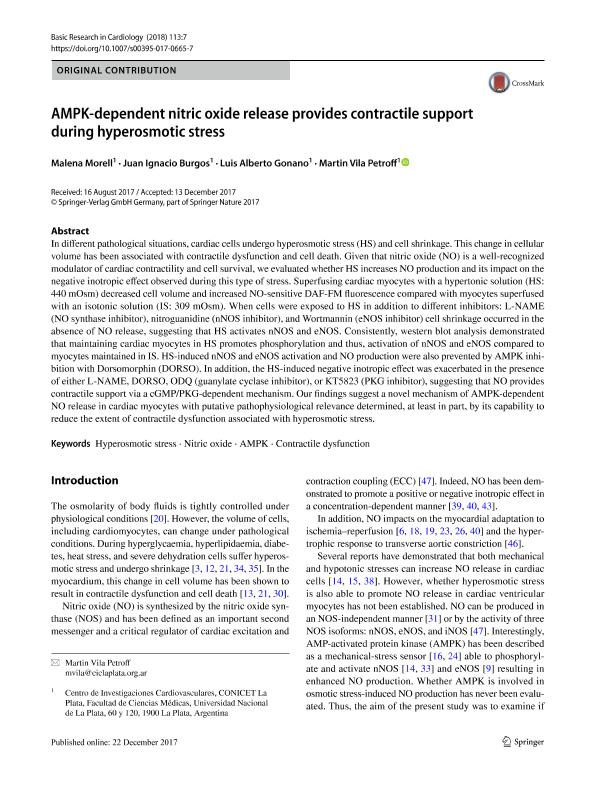Mostrar el registro sencillo del ítem
dc.contributor.author
Morell, Malena

dc.contributor.author
Burgos, Juan Ignacio

dc.contributor.author
Gonano, Luis Alberto

dc.contributor.author
Vila Petroff, Martin Gerarde

dc.date.available
2020-01-31T15:25:15Z
dc.date.issued
2018-01
dc.identifier.citation
Morell, Malena; Burgos, Juan Ignacio; Gonano, Luis Alberto; Vila Petroff, Martin Gerarde; AMPK-dependent nitric oxide release provides contractile support during hyperosmotic stress; Dr Dietrich Steinkopff Verlag; Basic Research In Cardiology; 113; 7; 1-2018; 1-11
dc.identifier.issn
0300-8428
dc.identifier.uri
http://hdl.handle.net/11336/96376
dc.description.abstract
In different pathological situations, cardiac cells undergo hyperosmotic stress (HS) and cell shrinkage. This change in cellular volume has been associated with contractile dysfunction and cell death. Given that nitric oxide (NO) is a well-recognized modulator of cardiac contractility and cell survival, we evaluated whether HS increases NO production and its impact on the negative inotropic effect observed during this type of stress. Superfusing cardiac myocytes with a hypertonic solution (HS: 440 mOsm) decreased cell volume and increased NO-sensitive DAF-FM fluorescence compared with myocytes superfused with an isotonic solution (IS: 309 mOsm). When cells were exposed to HS in addition to different inhibitors: L-NAME (NO synthase inhibitor), nitroguanidine (nNOS inhibitor), and Wortmannin (eNOS inhibitor) cell shrinkage occurred in the absence of NO release, suggesting that HS activates nNOS and eNOS. Consistently, western blot analysis demonstrated that maintaining cardiac myocytes in HS promotes phosphorylation and thus, activation of nNOS and eNOS compared to myocytes maintained in IS. HS-induced nNOS and eNOS activation and NO production were also prevented by AMPK inhibition with Dorsomorphin (DORSO). In addition, the HS-induced negative inotropic effect was exacerbated in the presence of either L-NAME, DORSO, ODQ (guanylate cyclase inhibitor), or KT5823 (PKG inhibitor), suggesting that NO provides contractile support via a cGMP/PKG-dependent mechanism. Our findings suggest a novel mechanism of AMPK-dependent NO release in cardiac myocytes with putative pathophysiological relevance determined, at least in part, by its capability to reduce the extent of contractile dysfunction associated with hyperosmotic stress.
dc.format
application/pdf
dc.language.iso
eng
dc.publisher
Dr Dietrich Steinkopff Verlag

dc.rights
info:eu-repo/semantics/openAccess
dc.rights.uri
https://creativecommons.org/licenses/by-nc-sa/2.5/ar/
dc.subject
AMPK
dc.subject
CONTRACTILE DYSFUNCTION
dc.subject
HYPEROSMOTIC STRESS
dc.subject
NITRIC OXIDE
dc.subject.classification
Fisiología

dc.subject.classification
Medicina Básica

dc.subject.classification
CIENCIAS MÉDICAS Y DE LA SALUD

dc.title
AMPK-dependent nitric oxide release provides contractile support during hyperosmotic stress
dc.type
info:eu-repo/semantics/article
dc.type
info:ar-repo/semantics/artículo
dc.type
info:eu-repo/semantics/publishedVersion
dc.date.updated
2019-10-16T16:06:15Z
dc.journal.volume
113
dc.journal.number
7
dc.journal.pagination
1-11
dc.journal.pais
Alemania

dc.description.fil
Fil: Morell, Malena. Universidad Nacional de La Plata. Facultad de Ciencias Médicas; Argentina
dc.description.fil
Fil: Burgos, Juan Ignacio. Universidad Nacional de La Plata. Facultad de Ciencias Médicas; Argentina
dc.description.fil
Fil: Gonano, Luis Alberto. Universidad Nacional de La Plata. Facultad de Ciencias Médicas; Argentina
dc.description.fil
Fil: Vila Petroff, Martin Gerarde. Universidad Nacional de La Plata. Facultad de Ciencias Médicas; Argentina
dc.journal.title
Basic Research In Cardiology

dc.relation.alternativeid
info:eu-repo/semantics/altIdentifier/url/http://link.springer.com/10.1007/s00395-017-0665-7
dc.relation.alternativeid
info:eu-repo/semantics/altIdentifier/doi/http://dx.doi.org/10.1007/s00395-017-0665-7
Archivos asociados
